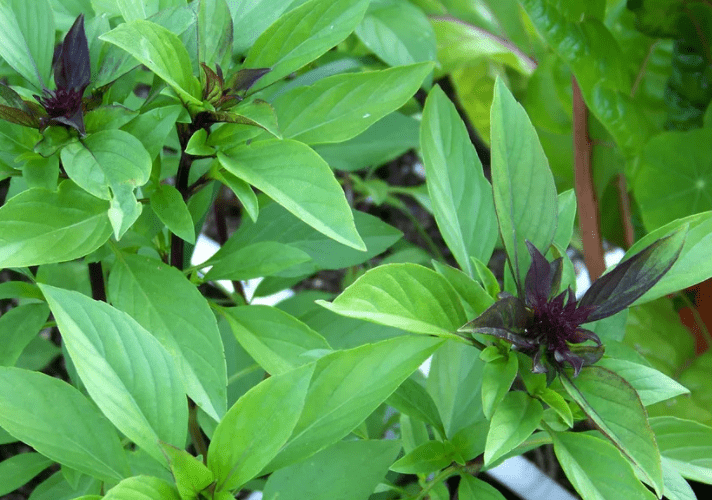Thai Basil
THAI BASIL is a member of the Ocimum basilicum family, including the bright green varieties used for pesto. With its purple stems and blossoms, the striking Thai basil has an effusive clove scent.
Using Thai basil instead of regular basil is like playing a chord versus a single note, says South Dartmouth grower.
How to use it: “You don’t want to put it in a soup and cook it for three hours,” advises Beth Jensen, herb product manager for Johnny’s Selected Seeds, a Maine-based farm and garden supply company.
The plant’s essential oils will break down with prolonged exposure to heat, says Jensen.
Thai cooks call the plant bai horata and add the herb uncooked to dishes at the last minute.
Thai Basil Details
THE HERB: Thai basil, rau que, or holy basil; different from sweet or Genoa basil.
THE SCOOP: One of the oldest herbs known to man, basil, originated in India and is widely grown throughout Southeast Asia (Thai basil or rau que) and southern Europe (sweet basil or Genoa basil).
Sweet basil releases its spicy aroma and flavor when it’s raw, while Thai basil develops its best flavor after being heated or torn into a vinegar-based dressing. Thai basil also works well in stir-fries or soups.
It’s almost always included with a classic bowl of pho, the ubiquitous Vietnamese noodle soup that involves chilis, cilantro, and lime wedges. I use the leaves whole in salad rolls, along with cilantro and green onion.
THE SOURCE: Asian markets usually stock Thai basil; the Italian Centre Shop and most supermarkets carry sweet basil as well as Amazon.
THE DISH: Saifun noodles, made from green mung beans, are also called bean threads or cellophane noodles and are especially good in cold dishes. If you can’t find a saifun, use a rice stick.
Give this salad at least 30 minutes in the fridge before serving, so the saifun can absorb the herbal flavor of the basil; saifun is a bland pasta with no flavor of its own.
Thai basil and Italian basil are subtly different, but either can be used in this salad. (Avoid chopping basil — tear it to avoid bruising the leaves.)
SAIFUN NOODLE SALAD
Serves 4
– 8 oz (250 g) package saifun bean thread noodles
– 1 cup (250 mL) grape tomatoes, whole
– 1 small English cucumber, diced
– 2 tablespoons (30 mL) chopped fresh mint leaves
– 2 or 3 green onions, minced
– a few cilantro leaves, chopped
DRESSING:
– 1/4 cup (50 mL) rice vinegar
– 3 tablespoons (45 mL) sugar
– grated zest and juice of 1 lime
– 2 tablespoons (30 mL) Thai basil or Italian basil, torn
– 2 garlic cloves, mashed
– 1 teaspoon (5 mL) red chile paste
– 2 teaspoons each, (10 mL) fish sauce and soy sauce
– 1/4 cup canola oil
– 1/2 teaspoon (2 mL) sesame oil
Soak saifun in a bowl of warm water until softened, about 5 minutes, then cook one minute in boiling water.
Drain and instantly rinse with cold water to stop the cooking. Saifun should be just tender.
Cover and keep in the fridge to the moment when ready to put the salad together.
Whisk together all ingredients for the dressing—taste to correct the seasoning.
Toss cold noodles in a large salad bowl. Add tomatoes, cucumber, mint, onions, and cilantro.
Pour dressing over the top and toss well. Let the salad rest in the fridge another 30 minutes before serving, so the saifun have a chance to absorb the flavors.
Basil Family
Generally, basils are grouped by taste (sweet, Genovese, Thai or other) or leaf: Large-leaf (Italian, lettuce-leaf); small-leaf (dwarf or bush); red-leaf, and the inevitable category, other.
The most familiar, sweet varieties are most often grown for use in sauces, soups, salads, or any dish with a robust tomato component.
Varieties include the bushes: Bush, Greek Bush, Purple Bush; the globes: Spicy Globe, Miniature Purple, and many more. The leaves are generally small, and the plants grow to a height and width of 8 to 12 inches.
The large-leaf varieties, also within the sweets, are often used for pesto. Types include Genovese, Compact Genovese, Mammoth, and the new wilt resistant variety, Genovese Nufar.
These plants grow to a height of 2 to 3 feet.
Purple or red varieties, such as Dark Opal and Purple Ruffles, are intermediates, smaller than the large leaf but more significant than the small leaf.
Ornamental and culinary, they add great color to the garden and are used in herbal vinegars or infused oils.
Other includes those with unusual scents (Lemon, Anise, Cinnamon, Lime, Spice, Camphor); Thai basils (Thai, Thai Magic, Queenette and Siam Queen); sacred (Tulsi Green, Tulsi Purple, Holy) and even a tree variety (Ocimum kilimandscharicum) native to eastern Africa.
The easiest way to grow basil (although a bit late for this year) is to start from seed. Richter’s, Nichol’s, and other catalogs for herb lovers carry a wide selection of sources.



























